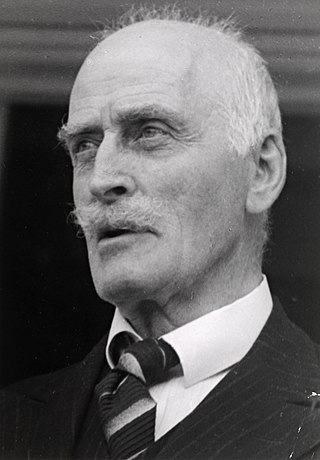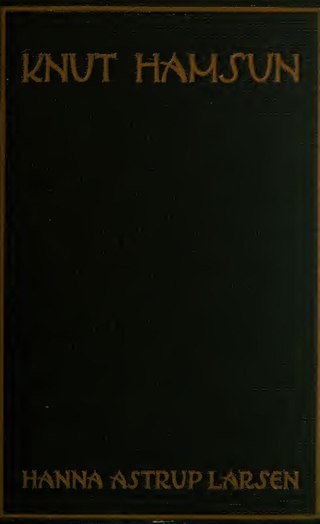Related Research Articles

Knut Hamsun was a Norwegian writer who was awarded the Nobel Prize in Literature in 1920. Hamsun's work spans more than 70 years and shows variation with regard to consciousness, subject, perspective and environment. He published more than 20 novels, a collection of poetry, some short stories and plays, a travelogue, works of non-fiction and some essays.

Pan is an 1894 novel by Norwegian author Knut Hamsun. He wrote it while living in Paris and in Kristiansand, Norway. It remains one of his most famous works.
In literature, psychological fiction is a narrative genre that emphasizes interior characterization and motivation to explore the spiritual, emotional, and mental lives of the characters. The mode of narration examines the reasons for the behaviors of the character, which propel the plot and explain the story. Psychological realism is achieved with deep explorations and explanations of the mental states of the character's inner person, usually through narrative modes such as stream of consciousness and flashbacks.
In Wonderland is a travelogue written by Knut Hamsun in 1903. It documents Hamsun's impressions during his visit to the Russian Caucasus, Persia and Turkey in 1899.
Benoni may refer to:

Hunger is a novel by the Norwegian author Knut Hamsun published in 1890 by P.G. Philipsens Forlag. The novel has been hailed as the literary opening of the 20th century and an outstanding example of modern, psychology-driven literature. Hunger portrays the irrationality of the human mind in an intriguing and sometimes humorous manner.
Pan is a 1922 Norwegian film directed by Harald Schwenzen. It was the first of four film adaptations of the novel of the same name by 1920 Nobel Prize winner Knut Hamsun, and one of the earliest Scandinavian adaptations of a Hamsun work. It tells the story of a romance between a wealthy woman and a soldier, and was filmed in Nordland and in Algeria.
Jørgen Haugan is a Norwegian author and lecturer. He was written a number of books, principally biographies of noted Scandinavian writers.
Edda. Scandinavian Journal of Literary Research is a magazine for research on Scandinavian literature, and for literary researchers in the Scandinavian countries. The magazine is based in Oslo.
James Walter McFarlane was a scholar of European literature, author of The Oxford Ibsen, and founding Dean of the School of European Studies at University of East Anglia which included Scandinavian studies.

Gabriel Langfeldt was a Norwegian psychiatrist. He was a professor at the University of Oslo from 1940 to 1965. His publications centered on schizophrenia and forensic medicine. He was involved as an expert during the trial against Hamsun, and wrote a book about Quisling.
Pan is a 1995 Danish/Norwegian/German film directed by the Danish director Henning Carlsen. It is based on Knut Hamsun's 1894 novel of the same name, and also incorporates the short story "Paper on Glahn's Death", which Hamsun had written and published earlier, but which was later appended to editions of the novel. It is the fourth and most recent film adaptation of the novel—the novel was previously adapted into motion pictures in 1922, 1937, and 1962.

Erasmus Benedicter (Benedigt) Kjerschow (Kjerskov) Zahl was a privileged trader and an island owner at Kjerringøy in Nordland, Norway. Zahl is known as Nobel Literature Prize laureate Knut Hamsun's monetary supporter, and a representative of the old, traditional Nordland—Hamsun's ideal society. He is also internationally known through the character Mack, who appears in several works of Hamsun, among them Pan (1894), Dreamers (1904), and Benoni and Rosa (1908).
Iselilja is a Norwegian feminine given name. In 2015, in Norway 17 people had the name as a first name and 15 people had it as a middle name, according to SSB's name statistics.
Dreamers is a novel by Knut Hamsun from 1904. The novel is among Hamsun's last set in Nordland and it contains many comical and caricatured people and events.
Sverre Lyngstad was a scholar and translator of Norwegian literature. He is renowned for his significant contribution to making Norwegian literature accessible to an English-speaking audience, for which he was awarded the St. Olav's Medal in 1987 and the Royal Norwegian Order of Merit, Knight's Cross, First Class in 2004. He is best known for his translations of and commentaries on the works of Knut Hamsun, which are widely credited for helping to popularise Hamsun's work in the US and UK.
The Last Joy is the third book in Knut Hamsun's "wanderer trilogy." The novel was published in 1912, when Hamsun was just over 50 years old and had much of his writing ahead of him, but already knew the weight of age. The novel is set in the first person; the narrator has lived his life and now has the last joy of opting out of everything and just being with himself in nature. However, in Hamsuns's manner he cannot do it without revealing his self-deception.
Queen Tamara is a three-act play by Knut Hamsun about Tamar of Georgia. It was published in 1903.
The Ring is Closed was the last novel by the Norwegian author Knut Hamsun. The book was published in 1936. In it, Hamsun writes once again about love that creates a fatal flaw for one party in a relationship.

Hanna Astrup Larsen was a Norwegian-American writer, literary editor, and translator.
References
- 1 2 Nancy L. Coleman; Olav Veka (2010). A Handbook of Scandinavian Names. Madison, WI: University of Wisconsin Press. p. 6. ISBN 9780299248338.
- ↑ Stefanie von Schnurbein (Summer 2001). "Failed Seductions: Crises of Masculinity in Knut Hamsun's "Pan" and Knut Faldbakken's "Glahn"". Scandinavian Studies. 73 (2): 156. JSTOR 40920298.